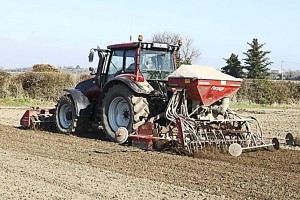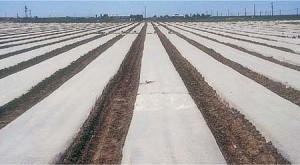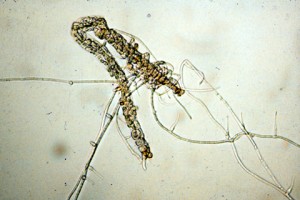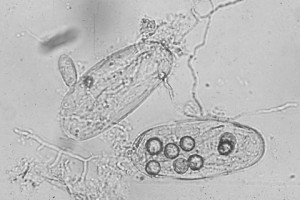Strategies for organic and precision farming
Organic farming is a method of agriculture where no synthetic fertilizers and pesticides are used, (FAO, 1998) while precision farming can be defined as the use of information and information technology to make implement management decisions at appropriate scales. Nematode management plays an important role in organic and precision farming. In nematode management it is important to remember that nematodes can move only very short distances. Therefore nematodes are mainly spread through lack of sanitation and movement of infected soil and planting material. In order to limit a build-up of nematodes, planting equipment and tools should be properly cleaned, and in extreme cases should only be used for the same field. Furthermore only soil and planting material free of nematodes should be used; because once nematodes are introduced into a field they cannot be eradicated. After harvest, infected plants should be destroyed to prevent the buildup of nematodes on crop residues and in the soil. Once they become established in a site, the nematodes will persist there, and management will be required on a regular basis.
Nematode Management Strategies in Organic Farming
Four different strategies for nematode management are:
- Preventing the introduction and spread of nematodes by the use of nematode-free planting materials.
- Using nonchemical, cultural, and physical control methods, particularly crop rotation and soil cultivation.
- Encouraging naturally occurring biological control agents by understanding of cultivation methods and appropriate use of soil amendments.
- Maintaining or enhancing the biodiversity inherent in traditional farming systems that use multiple cropping and multiple cultivars to increase the available resistance or tolerance to nematodes.
The various tools for management of nematode in organic farming are:
A) Resistant plants and rotation crops:
Nematode management is primarily a pre-planting activity. In order to protect the crop, most activities must be started two or three months before the scheduled planting date. Several pre-plant treatments are available for the organic farmer. The choice of a suitable crop cultivar can be a critical decision. Host plant resistance achieved by traditional breeding programs can be a valuable protection against some nematodes. Two terms that are often used when talking about host plant resistance to nematodes are “tolerance” and “resistance”. Tolerance means that the plant can withstand some damage caused by nematodes without experiencing significant yield reduction. In contrast, resistance means that nematode reproduction is very low or non-existent on the plant. Both provide protection for the crop plant, but the next crop following a tolerant plant could be damaged by the nematodes that survived on the tolerant plant. Different plant species or even cultivars of the same plant species can exhibit varying degrees of resistance or tolerance. The following vegetable plants are recommended as reasonably resistant to root-knot nematode: broccoli, brussel sprouts, mustard, garlic, leek, groundcherry, and rutabaga. In contrast asparagus, sweet corn, horseradish, some lima bean varieties, and onion are considered to be tolerant.
However, the crop rotation utilizes crops that are a poor or non-host to the nematodes found in an agricultural field. These crops can either be plants that provide a secondary cash crop grown in between cycles of the primary cash crop, or they could be cover crops that are not primary but provide benefits to the farming system such as nitrogen enrichment, nematode reduction, or possible additional income. In either case, nematode numbers are reduced simply because nematodes are deprived of a suitable host crop. This does not mean that nematode densities are reduced indefinitely, but a successful crop rotation should reduce nematode levels enough so that a following susceptible crop will produce sufficient yields and survive until the end of its regular growing season.
Concepts for a cropping system to manage nematodes include grass fallows, antagonistic plants and trap plants, cover crops that enhance the activity of beneficial soil fauna and flora, and shifts in the time for planting and/or harvesting of crops to limit nematode damage. Popular cover crops are sorghum, sorghum sudan grass, different grains such as oat and rye, many grasses, marigold, cowpea, and some tropical legumes such as sunn hemp and velvet bean. These cover crops are useful to reduce root-knot nematode population densities. Sorghum is often recommended as a cover crop to decrease population levels of root-knot nematodes, and is widely used for this purpose.
B) Tillage:

Tillage and the practice of fallowing fields may appear as alternatives to cover crops for nematode management. Tillage inverts and mixes soil and exposes deeper soil layers to the sun (Fig 1). This practice is meant to kill nematodes by desiccation, since nematodes depend on moisture for survival. This practice may kill some of the nematodes that are in the upper soil layers, however it will not reach nematodes that have retreated into moderate or deeper soil layers. Nematodes can retreat to depths greater than 12 inches (30 cm), and can migrate upward once a susceptible host is planted. Once a field has been fallowed, nematodes will move into deeper soil layers to avoid drying and may enter an inactive stage that enables them to survive periods without food and in addition protects them from desiccation.
C) Solarization:

A promising technique is the use of heat to decrease not only nematode densities, but also other harmful organisms and weed seeds. This can involve pasteurization, steaming, or solarization of the soil before planting. Of these, solarization is probably the most practical. It involves the covering of the soil with clear plastic. Transparent plastic sheets allow short-wave radiation from the sun to penetrate the plastic (Fig 2). Once the light passes through the plastic and is reflected from the soil, the wavelength becomes longer and cannot escape through the plastic. The trapped light facilitates heating of the soil to temperatures detrimental to most living organisms. There are different types of plastic sheets available, mainly differing in their thickness (insulation) and ability to let light through (transparency). Black, opaque, or translucent plastics are not suitable for solarization. Thin, transparent plastic sheets appear to achieve the best results. The plastic has to be sealed to prevent air movement underneath the plastic, which would prevent temperatures from rising sufficiently.
The disadvantage of solarization is its negative impact on beneficial soil organisms, since they will meet the same fate as their harmful counterparts. But recovery is usually attained quickly through rapid recolonization. Furthermore, other beneficials such as Bacillus, Pseudomonas, and Trichoderma are able to survive the high temperatures generated by solarization.
D) Biological control:
Biological control is the management of plant-parasitic nematodes by living organisms such as bacteria, fungi, predatory nematodes, or other invertebrates. Biological control is mainly accomplished by attempting to build up beneficial organisms through the use of various soil amendments. The introduction of beneficial soil organisms to the soil has only been attempted successfully in a few instances: e.g. Pasteuria spp., Pseudomonas spp., VAM fungi, Glomus spp., Trichoderma spp., etc. Nematode-trapping fungi (fig 3) are also potential candidates for biological control. Their adhesive knobs, rings, or net structures trap nematodes and kill them. Other types of fungi may parasitize nematode eggs/cyst (Fig 4).


E) Organic amendments in relation to biological control:
Biological control is difficult in soil, because it is a complex environment. Many of the possible organisms that could provide biological control lack specificity and therefore will not focus on a particular organism and may even interfere with beneficials. Therefore biological control of nematodes is achieved mainly by conservation of existing biological control; meaning that the soil environment is modified to aid the survival and reproduction of nematode natural enemies that are already present. Primarily this is accomplished through the addition of organic amendments. Organic amendments can improve the soil environment to aid biological control, benefit general plant health by helping with water retention and providing additional nutrients, and affect nematodes directly and negatively through detrimental decomposition products. In most cases when organic amendments are applied, they are helpful mainly as a plant nutrient source and do not directly aid in nematode management. However, even if nematodes are unaffected by the added amendments, plant health may improve due to other favorable properties of amendments. E.g. Neem cake, Karanj cake, etc.
F) Management of infected plants:
Once plants are infected with nematodes, there is little that can be done to remove or reduce nematodes. Therefore, prevention and sanitation are critical to controlling nematodes. The improvement of plant health is an important cultural technique to lessen detrimental effects on plants caused by plant-parasitic nematodes. Proper irrigation, fertilization and organic amendments as surface mulches or soil incorporated are important. Furthermore, removal of weed hosts and old crop plants immediately after harvest can reduce nematode densities for the future. Nematodes are a long-term pest, which cannot be eradicated once they become established in a site. They can only be kept at low levels with carefully selected management tactics that are often specific to the managed site. There are a variety of additional methods that may have some effect on nematodes. These include methods such as use of rhizobacteria, chitin, sesame residues, flooding, or microwave energy. Some of these (flooding, microwaving) may be restricted to specialized situations. Amendments such as chitin or sesame residue may provide nutrients that are beneficial to overall plant health regardless of any effects on nematodes.
Nematode Management Strategies in Precision Agriculture
Modern computerized harvest-management and data systems offer new opportunities for more precise management of nematodes and general crop production. This technology has the potential to improve water use and limit fertilizer and pesticide application on a spatial and temporal basis as dictated by soil fertility; and, more important, differential spatial crop yields. Based on early results, this management tool should allow specially prescribed nematode control in high-intensive crop production such as Radopholus similis on banana and root-knot nematodes on potato. Approaches that focus on a harvest index to locate environmental stress should be able to relate nematode kinds and numbers to poor yield and other stress factors. This approach is now being used in some banana operations in which fruit is harvested in small subunits and yield data are recorded and analyzed by computer. Poor-yielding sections can be examined for nematode densities and other potential problems.
A) Nematode identifications and population assessments
The tools of rDNA technology, especially when allied with traditional taxonomic characters and host differentials, have greatly facilitated identification of nematode species. Continuing restrictions in the size of samples and numbers of nematodes that can be examined make it very difficult to fully diagnose the nematode species present in large fields. However, this new technology should facilitate a more complete characterization of the diverse nematode trophic groups and species. Geostatistical analyses could be interfaced with improved sampling apparatus for more precise measurement of data on nematode population.
Image analysis has been adapted to count specific nematodes.
B) Genetically engineered and traditional host resistance
There has been considerable progress made in engineering host resistance to nematodes, genetic mapping, and diagnostics. However, genetically engineered resistance to nematodes is still at the developmental stage in contrast to the recently deployed herbicide- and insect-resistant cultivars of cotton, soybean, and other crops. One strategy involves transformation of plants with a transgene(s) encoding a product detrimental to the target nematode or that suppresses the expression of key plant genes involved in the nematode-host interaction. Candidate genes for this strategy include collagenase, genes expressed in the development of specialized feeding cells induced by species of Globodera or Heterodera (syncytia) and Meloidogyne (giant cells). Constructs of the root-specific TobRB7 gene in tobacco have been used to develop promising root-knot nematode-resistant genotypes. Linking this gene with a BARNASE gene resulted in root knot-resistant plants, but difficulties were encountered in recovering resistant lines from progeny of the transformants. Transformed plants with an antisense TobRB7 construct also exhibited root-knot resistance; root-gall development was about 70% less in than susceptible plants.
A second approach for engineering nematode-resistant plants involves identifying, cloning, and introducing natural plant-resistant genes into susceptible crop plants. Exciting results with this strategy were recently reported with Heterodera schachtii on sugar beet. In one major development, Cai et al cloned the cyst-resistant gene in wild Beta species. A transformed, normally susceptible sugar beet line exhibited the typical incompatible resistant reaction. Similar progress is being made with the Mi gene, which confers resistance to the common Meloidogyne species and populations attacking tomato. With the wide host range of these nematodes, the transfer of the Mi gene to numerous crop species, for which root-knot nematodes affect major crop yields, has great economic promise.
[infobox]K. Suryawanshi1 and V. B. Shinde2
1Ph.D. (Agri.) Scholar, Department of Plant Pathology, MPKV, Rahuri (MS)
2Ph.D. Horti. (Fruit Science) Scholar, Department of Horticulture, JAU, Junagad (GJ)
Email: suryawanshikk@gmail.com.
[/infobox]












